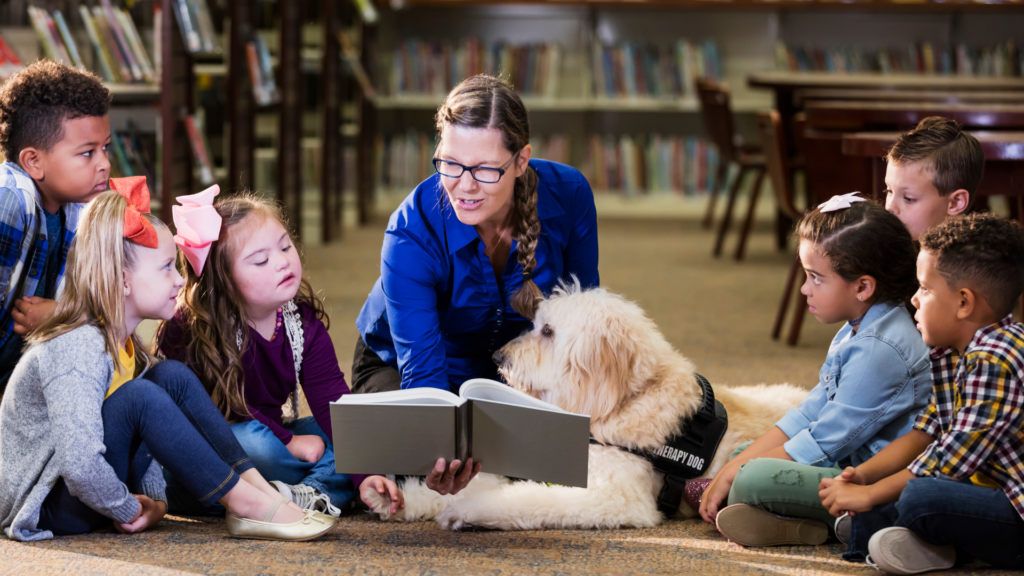There is a growing number of teachers in Flanders bringing a pet or therapy dog into the classroom as success stories of calmer, more empathetic students come to the surface. While risks remain, there have been no reports of instances revolving around the classroom dogs as of yet.
A primary school in Overijse adopted a concept developed in the 1990s by German teacher Bernd Retzlaff who had brought Jule, his labrador, to school. Following the lead of Retzlaff who saw many benefits for his students, Melissa – the teacher of 3A at 't Kasteeltje – decided to introduce her class to her puppy Kenai. Other teachers at 't Kasteeltje have also noticed the advantages of having Kenai in the classroom.
In much the same way that Retzlaff saw positive changes in his pupils, Melissa has also seen quiet children open up and more boisterous children calm down. In addition, academic results have also been on the rise since Kenai’s arrival.
Social and learning difficulties after lockdowns
The 't Kasteeltje teacher landed on the idea after returning to the school after the pandemic and her maternity leave and had a class which she describes as "challenging". The period of confinement during the Covid-19 outbreak led to problems in her class which featured some children with learning disabilities and others with social problems.
She first asked permission from the school’s management and when the parents also agreed, Kenai suddenly had a job that made Melissa's a lot more pleasant. "Such a dog has an exceptional calming effect," she told Het Nieuwsblad. "It's easier to get a tough class to be quiet because otherwise the dog will get scared and that’s a bigger motivator than just having your teacher telling you."
The benefits of having a dog at school have been investigated at a scientific level. After Bernd Retzlaff’s experience with Jule, the Konrad Lorenz Kuratorium in Zurich set up an experiment featuring 30 Swiss teachers who had to bring their cat or dog to class. The results were consistent: communication between the class and teacher improved, the children had more respect for living beings, and their sense of responsibility and empathy also improved.

Credit: Canva
The primary school in Overijse is not the only one to adopt this approach. Ann Peeters, a fifth-grade teacher at the Merksem primary school Laerhof, has brought her dog Polly into the classroom. "My students know very well that they can't leave anything lying around during snack time and that they certainly can't drop chocolate," she told Het Nieuwsblad.
Polly also brings structure. "I've had to take turns to determine who can come along to let her out during playtime, otherwise there will be a fight," she laughed. Those walking moments are worth their weight in gold, she added. "It's an opportunity to talk 'differently' with the children who come along. You have an icebreaker on a leash, and you are outside the school walls. Topics that are not covered in class can be talked about."
The popularity of the idea is spreading. Organisations that provide therapy dogs are now receiving calls from schools enquiring about how best to bring animals into the classroom.
"Every week we receive around six requests to train therapy animals," Inge Pauwels, director of Therapiedier vzw, told Het Nieuwsblad. "At least two of them come from teachers who see a class dog in their own dog."
But such training for dogs and owners costs a lot of money: around €1,500 euros. "That often scares me," Pauwels said. "Sometimes those teachers go to work with their dog without training. But that's dangerous, after all, you're dealing with children." Not every 'sweet dog' is suitable as a class dog.
"With all aspiring therapy animals, the most crucial question is: Does the animal like this? You can train a dog not to bark and to stay quiet in its basket, but if it experiences the many stimuli of a school environment as stressful, you ignore the animal's well-being. With all the consequences that entail." Such as bite incidents, but also smaller incidents. A Labrador is already big enough to knock a child over.
Related News
- Experts urge caution as popularity of labradoodles and other cross-breeds increases
- Vets offer advice as cases of poisoned pets continue to rise in Belgium
"That can lead to insurance issues," Pauwels added. "That is why we always do a 'Socially Acceptable Behaviour' test. This determines whether a dog is suitable as a therapy animal or not. Many insurance companies request that test or have one taken if problems occur."
“We, therefore, offer these training courses. The dogs that are trained with us are also insured in case they bite the remote control of the smartboard."
There have been no reported incidents in the schools so far and the dogs are always on a leash in the playgrounds and all children are told how to behave around the dog.
"Initially, some parents were reluctant," Melissa concluded. "But now there is a waiting list for the children who will want to transfer to my year. Because they all want to go to class with the dog."


